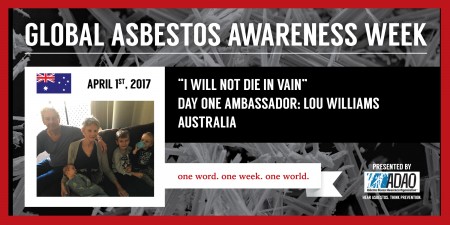Posted April 1, 2017
 Each year, ADAO dedicates April 1-7 to increasing awareness of asbestos and preventing exposure by bringing together experts and victims from around the world to share, learn, and take action. To view all 7 days of Global Asbestos Awareness Week (GAAW) contributors and content on our landing page, please click here.
Each year, ADAO dedicates April 1-7 to increasing awareness of asbestos and preventing exposure by bringing together experts and victims from around the world to share, learn, and take action. To view all 7 days of Global Asbestos Awareness Week (GAAW) contributors and content on our landing page, please click here.
Asbestos is a known carcinogen and there is no safe level of exposure. Since the 19th century, asbestos was widely used in construction, shipbuilding, and the automotive industry. Without a ban, asbestos remains legal and lethal in the USA and nearly 70% of countries around the world today.
Today, we will be highlighting the critical resources from the World Health Organization (WHO) about asbestos exposure and the elimination of asbestos-caused diseases. We will also be featuring the powerful personal story from Lou Williams, our GAAW Day One Ambassador: “I Will Not Die in Vain” – Lou’s Story.
Exposure to asbestos can cause mesothelioma, lung, gastrointestinal, colorectal, laryngeal, and ovarian cancers; as well as non-malignant lung, and pleural disorders.
What does than mean? In the USA it is estimated that 2,500 – 3,000 Americans die annually from mesothelioma. Using the WHO risk ratio, that means an estimated 15,000 – 18,000 Americans die annually from asbestos-caused lung cancer.
The WHO estimates that more than 107,000 deaths each year around the world are attributed to occupational exposure to asbestos, yet most people are unaware of its existence and dangers. This is so problematic, as asbestos-caused diseases are 100% preventable — you just have to prevent asbestos exposure. Awareness and education campaigns by WHO, GBAN, ADAO, and other public health organizations aim to help people learn lifesaving prevention techniques.
In a 2006 paper by the WHO, four essential recommendations to eliminating Asbestos-Related Diseases were referenced. These four action items are:
- By recognizing that the most efficient way to eliminate asbestos-related diseases is to stop the use of all types of asbestos
- To provide information about solutions for replacing asbestos with safer substitutes and developing economic and technological mechanisms to stimulate its replacement
- To take measures to prevent exposure to asbestos in place and during asbestos removal (abatement)
- To improve early diagnosis, treatment, social and medical rehabilitation of asbestos-related diseases and to establish registries of people with past and/or current exposure to asbestos.
In 2014, the WHO published the Chrysotile Asbestos report to “assist Member States of the World Health Organization (WHO) in making informed decisions about management of the health risks attached to exposure to chrysotile asbestos.” As we continue to fight for a global asbestos ban, institutions like the WHO are crucial in disseminating information and resources to help reduce the risk of asbestos-caused diseases. Be sure to keep up with the latest news and research coming from the WHO by connecting with GBAN and ADAO on social media.
Together, we make change happen.
Linda Reinstein

